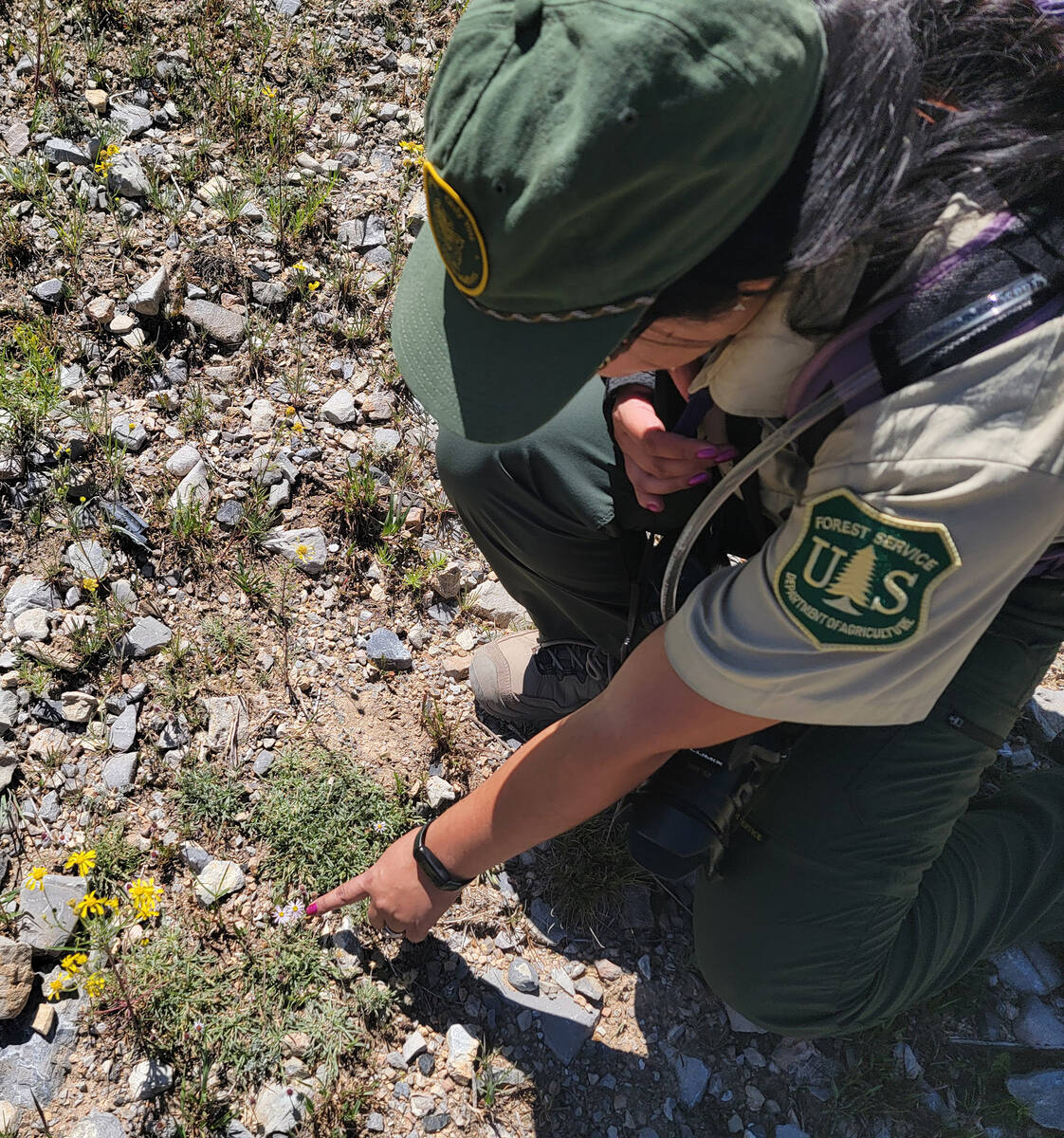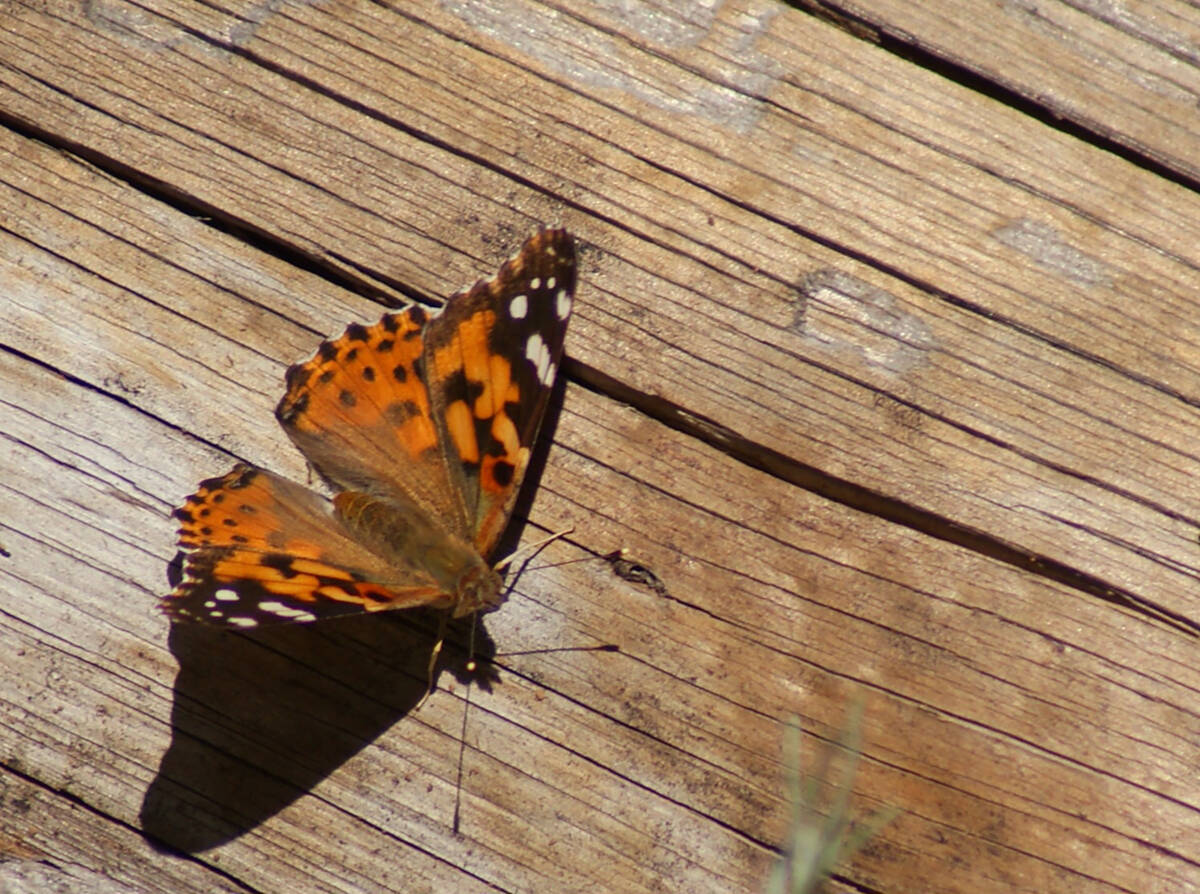Hiking Mount Charleston in pursuit of rare butterflies
Four rare butterfly species have fluttered into view during my continuing quest to photograph the endangered Mount Charleston blue butterfly. Forest-sent consolation prizes that I can’t complain about: Nevada admirals, Spring Mountains acastus checkerspots, Carole’s silverspots and Spring Mountains icarioides blues.
All are exquisite. All are found in Southern Nevada and nowhere else.
A total of eight butterfly species called endemics are living isolated lives on “sky islands” west of Las Vegas. At their highest point, Southern Nevada’s Spring Mountains rise to a peak of nearly 12,000 feet above sea level while being surrounded by the Mojave Desert.
Animals are stuck on “sky islands” because conditions at higher elevations have favored life for them since most of Southern Nevada warmed up and dried out after the last Ice Age about 11,000 years ago.
The butterflies are restricted in population because they are only found within a geographically limited range. They may have close relatives elsewhere in the Western U.S., but their time in isolation has created differences that make them distinctive.
Active at high elevations
While local hikers escape the urban heat of July and August to get some outdoor exercise in the mountains, they’ll also have the possibility of encountering Mount Charleston’s endemic butterflies along several trails in Kyle Canyon, on North Loop Trail off Deer Creek Road and along Lower Bristlecone Trail on the Lee Canyon side. Visitors also might spot butterflies in picnic areas and meadows. Endemics and more common butterfly varieties may be seen drinking nectar and pollinating flowering plants. Where there are wildflowers, there’s the opportunity to witness fanciful flights of butterflies. Luck always plays an important role in the equation, especially for those also hoping to take pictures of these rarities.
“Summer is a great time to enjoy plants and wildlife at higher elevations of the Spring Mountains National Recreation Area,” U.S. Forest Service district botanist Julie Wallis said in late June. “Endemic butterflies of the Spring Mountains are active at high elevations in the summer. Just this week we observed the endangered Mount Charleston blue butterfly around 9,000-feet elevation. You’ll certainly see butterflies on any high-elevation hike, and perhaps you’ll be lucky enough to spot a species unique to the Spring Mountains!”
Three of the Spring Mountains’ eight endemic butterflies resemble each other with their small 1-inch wingspan, blue color and miniature wing markings. Those markings are the key to identification. Among the three endemics and more than a dozen other more common small blue butterfly species, the most famous is the hard-to-find Mount Charleston blue butterfly, which was added to the endangered species list by the U.S. Fish & Wildlife Service in 2013.
In July 2024, U.S. Forest Service wildlife biologist Olivia Curtis showed me plants that “MCBBs” favor for food, including Clokey fleabane and Lemmon’s bitterweed. She also pointed out the ground-hugging plants where females lay their eggs and their caterpillars feed. “Once you see the larval and nectar sources, you’re in their habitat,” Curtis said.“That’s where you’ll see the butterflies.” We didn’t see any Mount Charleston blues that day, but by late July 2024 Curtis had already seen about 20 along the North Loop Trail and at a Lee Canyon picnic site.
Other sightings
The other two small blue endemic butterflies are the Spring Mountains dark blue and the Spring Mountains icarioides blue. On the South Loop and Acastus trails on the Kyle Canyon side of the Spring Mountains National Recreation Area, I have photographed the icarioides blue in late June with its small arcs of black dots on the forewings and white dots on the hindwings. Both times, the rare butterflies were on or near silvery lupines, their larval host plant.
The easiest endemic to spot, I’ve found, is the Nevada admiral with its 3-inch wingspan and a tendency to leisurely perch and spread out its elegant black and white wings. South Loop, Fletcher Canyon, Little Falls and Acastus trails have all yielded Nevada admiral sightings and photos. The butterfly spends its time aloft in the Spring and nearby Sheep Mountains from mid-May through October, in habitats from Pinyon woodland to subalpine forest.
When consulting Wallis in June for tips on spotting the Spring Mountains acastus checkerspot, she pointed me in the direction of two plants along the wash in lower Kyle Canyon, an area connected to the Acastus Trail and directly beneath the Mount Charleston hotel and Spring Mountains Visitor Gateway. Look for green rabbitbrush and yerba santa, Wallis said. Lining the trail was the ubiquitous rabbitbrush, the acastus checkerspot’s larval host. I stopped when I saw a flowering yerba santa bush and impatiently waited 15 minutes with my camera at the ready. I then explored farther down-canyon before returning to the yerba santa for another 15-minute shift. Out of left field and flying in low was a handsome 2-inch Spring Mountains acastus checkerspot, which fed for five minutes on the yerba santa’s nectar as I watched in awe.
Deer Creek, Stanley B. Springs and Fletcher Canyon trails are possible locations to find Carole’s silverspot through August. Fuchsia and lavender thistle flowers attract this butterfly, which is partly named after the actress Carole Lombard, who died in 1942 after a TWA plane she was traveling in crashed into Mount Potosi in the southern portion of the Spring Mountains. Carole’s silverspot’s larval host plant is the Charleston violet, an endemic plant with yellow flowers that bloom in May and June.
‘Incredibly resilient critters’
Butterfly wings often display dramatic differences in color and pattern between their upper surfaces (dorsal) and lower surfaces (ventral). With the Carole’s silverspot and acastus checkerspot, I studied images in guidebooks and on the internet that showed veins and geometric patterns on the dorsal wings before feeling more confident about endemic identifications. Southern Nevada Conservancy posts a helpful resource online at gomtcharleston.com.
In addition to possibly encountering Mount Charleston rarities flying near summer trails, hikers are likely to spot more common butterflies. I’ve witnessed a “puddle party” of probable spring azure butterflies drinking and absorbing nutrients like sodium from the muddy ground. I’ve photographed graceful swallowtails drinking from elegant red and yellow columbines. I’ve admired the ragged edges of a hoary comma’s wings and the impressive color complements of a California sister’s ventral surface. I’ve seen a stray monarch feeding on the rabbitbrush’s yellow flowers in September.
Beauty is only part of the story of Mount Charleston’s butterflies.
“They are very specialized, incredibly resilient critters,” said Spring Mountains National Recreation Area District Ranger Katy Gulley. “They live under the soil or cling to plants during winter until conditions are right to emerge.”
Butterflies in the form of eggs, larvae or chrysalises stay alive under snow cover in the high elevations in a dormant state called diapause. Because they are cold-blooded, butterflies need the sun’s warmth in open, flowery spaces before they put their wings in motion in late spring.
One of the most important steps visitors can take to help Mount Charleston’s butterflies survive, Gulley said, is to not hike off trail. Plants on the forest floor need to be protected from being crushed because tiny eggs and larvae could be hidden on them.
There’s a certain mystique surrounding butterflies, and Gulley said she hopes visitors enjoy a deeper connection to the Spring Mountains during each butterfly encounter. “Seeing a butterfly in flight helps people appreciate being in nature,” she said. “I hope it makes them kind of stop and appreciate that being in nature is a special experience.”




























